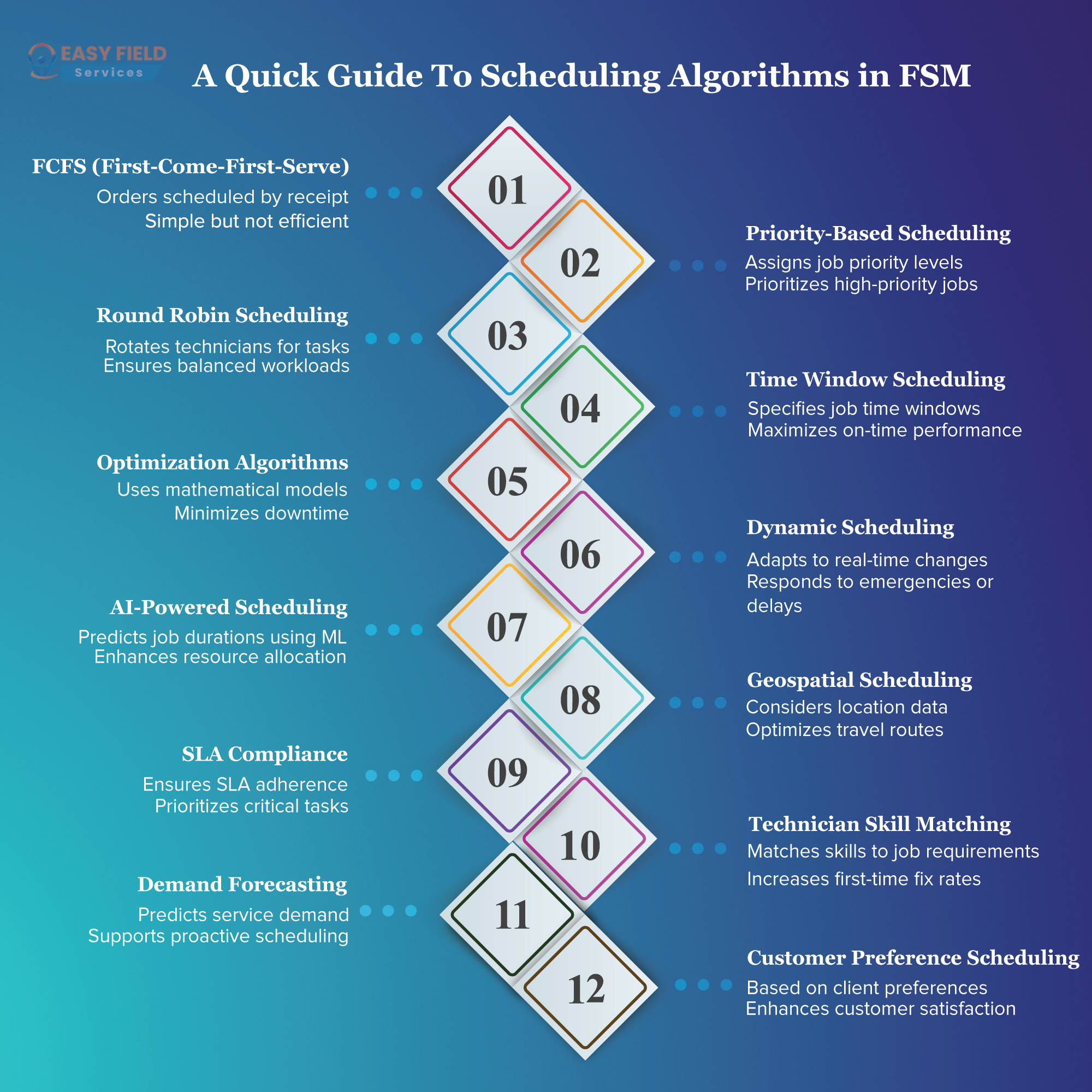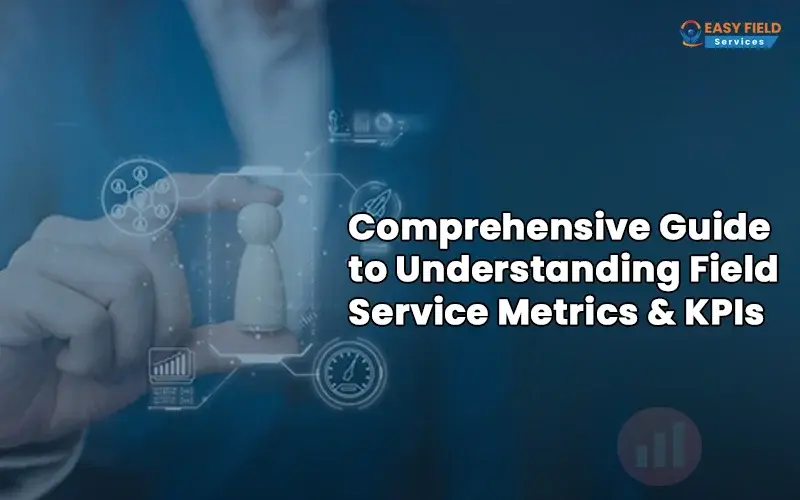A Guide to Scheduling Algorithms in Field Service Management
Overview
- A Comprehensive Exploration of Various Field Service Scheduling Algorithms
- 1. First-Come-First-Serve (FCFS)
- 2. Priority-Based Scheduling
- 3. Round Robin Scheduling
- 4. Time Window Scheduling
- 5. Optimization Algorithm
- 6. Dynamic Scheduling
- 7. Client Preference Scheduling
- 8. Geospatial Scheduling
- 9. SLA Compliance
- 10. Technician Skill Matching
- 11. Demand Forecasting
- 12. AI-Powered Scheduling
In the fast-paced realm of field service management, the strategic deployment of scheduling algorithms stands as a cornerstone for success. From conventional approaches such as First-Come-First-Serve (FCFS) to cutting-edge AI-powered scheduling. Each algorithm brings distinct strengths to the table for field service businesses. Before you delve into the array of algorithms. You need to grasp the essence of a field service scheduling algorithm. A systematic method integral to the work order scheduling process, ensuring efficient task organization and assignment.
Field service scheduling algorithms play a pivotal role in optimizing task scheduling, effectively allocating resources, setting priorities judiciously, and bolstering overall operational efficiency. Whether your business is embracing conventional methods or integrating state-of-the-art AI-powered scheduling. Each algorithm adds unique value to orchestrate field service tasks. Incorporating these algorithms into your field service scheduling software is paramount for optimizing service efficiency and enhancing overall operational effectiveness.
Whether you’re considering distinct field service scheduling software for various business processes or seeking a unified solution. You should prioritize choosing the right scheduling algorithm. This comprehensive guide aims to explore a range of scheduling algorithms, offering insights that not only streamline workforce scheduling but also elevate the productivity of your service business to new heights.
A Comprehensive Exploration of Various Field Service Scheduling Algorithms

1. First-Come-First-Serve (FCFS)
FCFS operates as a basic principle of handling tasks in the particular order they are received. This simplicity can be advantageous for managing straightforward service structures. However, in more complex scenarios specific to field service management, FCFS may lead to many challenges. For instance, FCFS cannot consider the urgency or priority of tasks related to field service calls, potentially resulting in delays for critical assignments. As organizations in the field service industry evolve and face increasing service complexities. There is a need to explore more tailored scheduling approaches which are discussed further in this guide.
2. Priority-Based Scheduling
Priority-Based Scheduling introduces a crucial element into the field service workforce scheduling process by assigning priority levels to field service tasks. This allows you to strategically prioritize high-impact or time-sensitive assignments, ensuring that critical tasks take first over others. In field service environments with diverse offerings, such as maintenance, repairs, and installations. Priority-based field service scheduling becomes a valuable tool for optimizing overall service delivery. By categorizing field service tasks based on importance and urgency. This algorithm ensures that essential works are addressed promptly, contributing to improved client satisfaction and operational efficiency.
3. Round Robin Scheduling
Round Robin Scheduling is a method that aims to maintain a fair distribution of workload among field service technicians. In this algorithm, field service tasks are cyclically assigned to technicians. Preventing any single technician from being overloaded with work. Round-robin scheduling promotes fairness in task assignment and contributes to a balanced field workforce scheduling among your service professionals. It’s important to consider the varying complexities of tasks. In field service scenarios where tasks have different levels of difficulty or time requirements. Additional factors may need to be incorporated to ensure optimal efficiency in task allocation and technician utilization.
4. Time Window Scheduling
Time window scheduling focuses on optimizing on-time performance by specifying predefined time frames for field service task completion. This algorithm is particularly beneficial in field service industries. Where strict adherence to timelines is critical, such as emergency response services or scheduled maintenance. By establishing time windows for field service task completion. You can ensure that services are delivered within specified timeframes, contributing to increased reliability and client satisfaction. However, it’s essential to strike a balance between stringent time constraints and the practicalities of field service task completion to avoid potential challenges and ensure operational effectiveness.
5. Optimization Algorithm
The optimization algorithm represents a leap into the realm of mathematical processes in field service scheduling. This algorithm goes beyond simple task assignments and incorporates mathematical models to minimize downtime and maximize resource utilization in the context of field service operations. By analyzing factors like your service technician’s availability, travel times, and task complexities, the optimization algorithm generates finely tuned-schedules. This level of optimization not only reduces idle periods for your field service technicians but also contributes to overall cost-effectiveness by efficiently utilizing available resources. The optimization algorithm is a powerful tool for your organization aiming to achieve a delicate balance between operational efficiency and resource management.
6. Dynamic Scheduling
In the dynamic and unpredictable field service environment, the ability to adapt to real-time changes is crucial. Dynamic scheduling excels in scenarios where unexpected events, emergencies, or delays are commonplace in the field service industry. This algorithm ensures that schedules remain fluid and responsive, allowing your organization to deploy resources where they are most needed. This acts as a key strategy for maintaining operational agility and addressing unforeseen challenges immediately in the field service sector. Furthermore, it enables your organization to navigate service uncertainties effectively, contributing to enhanced client satisfaction and service reliability.
7. Client Preference Scheduling
The client preference scheduling algorithm tailors schedules based on client preferences. By taking into account factors such as preferred service times or specific technicians. This algorithm ensures a personalized and satisfactory experience for clients. Client preference scheduling is a testament to the growing importance of user-centric approaches in modern service management within the field service industry. This algorithm not only meets the technical requirements of field service management but also aligns with the client’s individual preferences, contributing to enhanced client loyalty and positive brand perception. As field service organizations prioritize client satisfaction. The client preference scheduling algorithm becomes a valuable tool for building strong, long-lasting client relationships.
8. Geospatial Scheduling
9. SLA Compliance
Service Level Agreements (SLAs) are contractual commitments that you make to your clients regarding the delivery of services. This algorithm is designed to not only meet but exceed these agreements. By prioritizing field service tasks based on SLA requirements, you can ensure that critical assignments are given the attention they need to meet service-level expectations. SLA Compliance is crucial for maintaining client satisfaction, building trust, and upholding the contractual commitments made to clients in the field service sector. This algorithm becomes a vital factor for service industries where meeting specific service levels is crucial.
10. Technician Skill Matching
The technician skill matching algorithm emphasizes the importance of aligning the right skills with the right field service tasks. By ensuring that technicians with the appropriate expertise are assigned to specific assignments, organizations can significantly improve their first-time fix rates in the field service industry. This not only enhances operational efficiency but also contributes to client satisfaction by resolving field service issues promptly and accurately. Technician skill matching recognizes the diversity of skills within a technician workforce and aims to optimize field service task assignments based on individual strengths. As field service organizations focus on delivering high-quality services, this algorithm becomes an essential component of their scheduling strategy.
11. Demand Forecasting
In the ever-evolving landscape of field service management, the demand forecasting algorithm actively analyzes historical data and trends to offer insights into future service demand. Equipped with this knowledge, field service organizations can proactively approach scheduling, optimize resources, and stay ahead of client needs. This approach transforms into a proactive strategy for resource management, enabling field service organizations to efficiently allocate resources and ensure they are adequately prepared to meet anticipated service demand. This algorithm stands as a valuable tool for field service organizations aiming to stay agile and responsive in a rapidly changing service environment.
12. AI-Powered Scheduling
AI-powered scheduling transforms the field service scheduling process by integrating machine learning capabilities. This advanced algorithm elevates scheduling by predicting field service job durations through sophisticated algorithms. Instead of relying solely on historical data, AI-powered scheduling actively optimizes schedules based on predictions. It dynamically adjusts to evolving conditions and factors influencing field service job durations, thereby enhancing resource allocation and overall operational efficiency in the field service industry.
In summary, choosing a scheduling algorithm is not a one-size-fits-all decision. We discussed various scheduling algorithms, each serving a specific purpose, addressing unique challenges and opportunities within the field service environment. These algorithms, crucial for achieving operational excellence, optimize tasks and improve client satisfaction. However, to outpace competitors in a field service business, it’s not just about algorithms; it’s about the holistic adaptation of cutting-edge technology. Discussing scheduling algorithms is pointless without adopting the necessary resources to implement these algorithmic changes into your field service business. Take the first step toward transforming your field service operations today by choosing fully equipped, best-in-class field service scheduling software to stay ahead in the dynamic field service management landscape.





